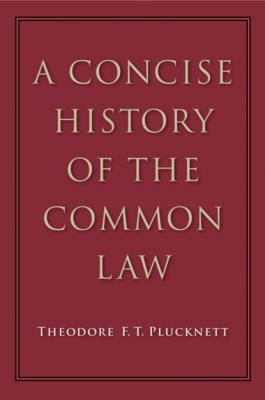A Concise History of the Common Law. Theodore F. T. Plucknett
Читать онлайн.| Название | A Concise History of the Common Law |
|---|---|
| Автор произведения | Theodore F. T. Plucknett |
| Жанр | Юриспруденция, право |
| Серия | |
| Издательство | Юриспруденция, право |
| Год выпуска | 0 |
| isbn | 9781614872474 |
Clearly it is only the fact of the Norman Conquest, seconded by the organisation of the Norman kings, that enabled England to be so centralised as this. In the course of two hundred years not only had the central courts at Westminster been erected and furnished with royal law and procedure where previously there had been little or none, but in addition the idea of royal supremacy and of the centralisation of justice had so firmly taken root that it was possible to assert that all judicial power, whether it be in royal courts, seignorial courts or the ancient communal courts, was exercised by delegation from the Crown. From this point onwards the character of the local courts was gradually being transformed in order to make them fit in with this theory. In the end, they were either to be abolished or virtually superseded by new institutions which would be in fact as well as in theory created by the Crown.
THE CROWN AND THE JURY
The ultimate supremacy of the central courts of the Crown was only achieved slowly. There was little direct attack, save perhaps a few words in the Statute of Gloucester (1278), c. 8, and the important rule in the Statute of Marlborough (1267), c. 20;1 for the most part, the change was effected by peaceful penetration and skilful competition in offering better remedies, notably, trial by jury. The points of contact between central and local courts thus become particularly significant. On the one hand, there is the Crown’s determined endeavour to tame the sheriff; on the other, there is the Crown’s use of the jury. It had long been the practice for royal emissaries to summon juries when the central government wished to make contact with the men of the county, hundred or vill. When, in later times, the jury was given the new function of trying issues of fact reached in litigation, the Crown claimed to have the monopoly of what had now become a desirable procedure, and thereby achieved an overwhelming superiority over those jurisdictions whose powers did not extend that far.
Such, then, is the general trend of institutional history in the course of a thousand years. It now remains to consider in a little more detail the rise and fall of local institutions, and their gradual subjection to the central authority. First of all we shall treat of the communal courts; secondly, of seignorial jurisdiction and its relations with them; then of the Crown’s contact with the local courts, and of the jury which grew up at that point of contact; and finally, of the royal courts at Westminster which were destined to overshadow and destroy both the seignorial and communal courts.
THE COMMUNAL COURTS
SUMMARY
The Sheriff’s Tourn: Courts Leet
The Suitors in the County Court
The Sheriff as Judge: Viscontial Writs
THE VILL OR TOWNSHIP
Beginning at the very bottom of the scale, the lowest institution we find is the vill or township.1 It is moreover the most complicated and obscure. Its history was possibly different in different parts of the country and is extremely difficult to disentangle from that of certain other institutions—the ecclesiastical unit of the parish, the social unit of the village, and the economic unit of the manor, which are all the subject of learned controversy. It would seem as if the typical vill (if one can use the term of an institution which varied so greatly) would have looked something like this. There will be a little group of houses, sometimes in a cluster, and sometimes ranged along an ancient road. Nearby there will be the parish church, and in many cases there will be the hall or mansion of the lord of the manor, if it so happens that the vill coincides with a manor, which may or may not be the case; sometimes a manor consists of several vills; on the other hand, a vill may contain several manors. Surrounding it there will be two, or more usually three, large fields. Each of these fields will be divided into a large number of long, narrow strips of about half an acre each, and every household in the village will own a greater or less number of these strips scattered irregularly through the fields. This system of scattered strips is very ancient and lasted long after the middle ages. It has been suggested that the method was imported by the Anglo-Saxons and was not native to England. The prehistoric field seems to have been a small irregular plot; the Celtic field which replaced it in England was apt to be oblong owing to the necessities of ploughing. It seems also to have been a peculiarity of Celtic agriculture to prefer hills or elevated ground, while the Saxons introduced valley settlements. The Saxons, moreover, were accustomed to use the large team of eight1 oxen to draw their ploughs; this, of course, gave more power, but made turning more cumbersome. Consequently it became necessary to plough a much longer furrow in order to secure the advantage of the larger team, and hence the long narrow strips—but why they were scattered, has long been debated. It was never easy to believe that an egalitarian dogma was applied regardless of efficiency and convenience; more probably, those who co-operated in each day’s ploughing took a share each, as the work proceeded from day to day.2 It is not uncommon for fields in England at the
